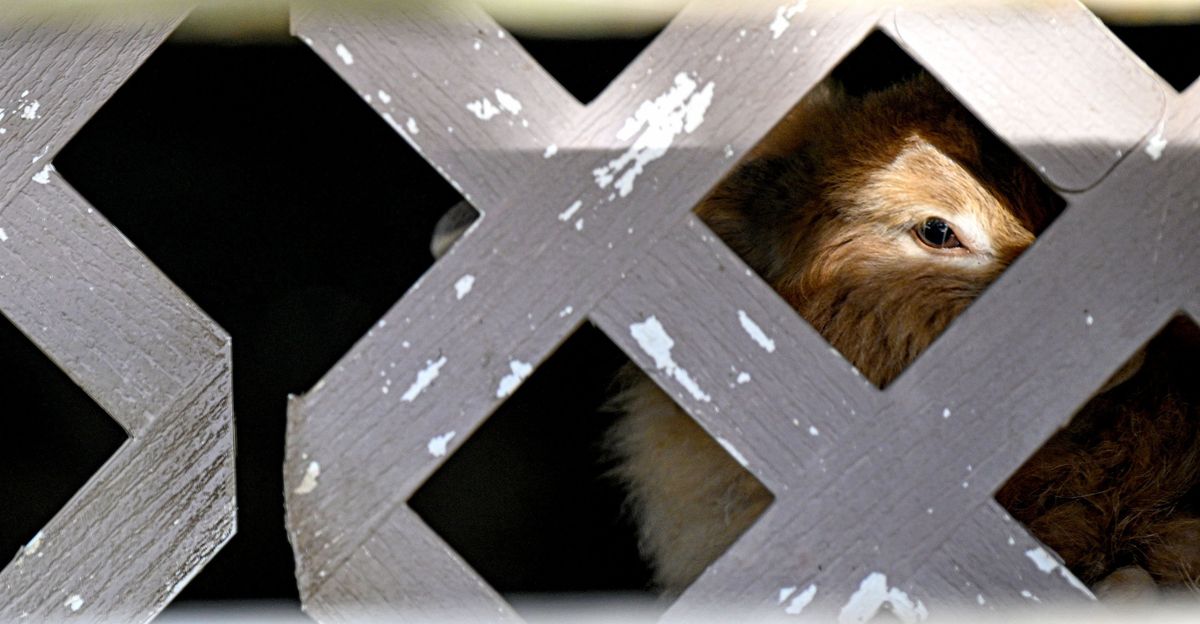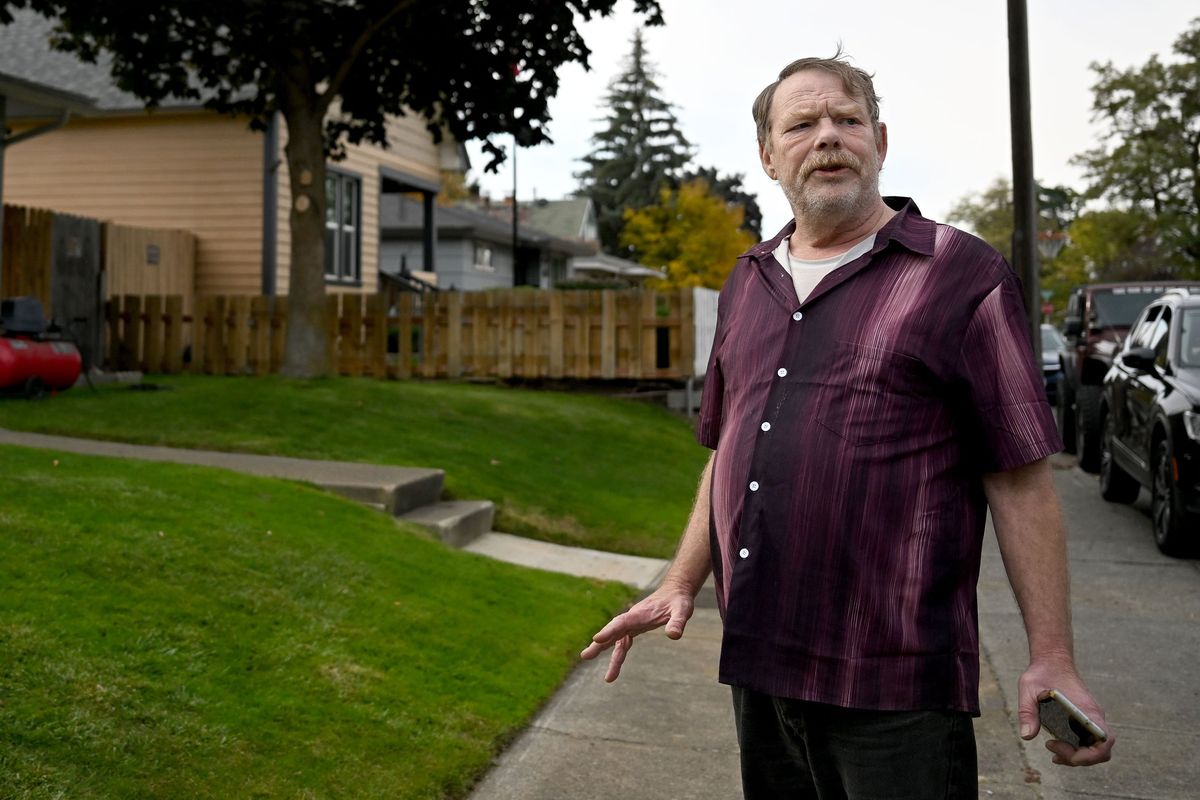Rabbit horde roaming part of the Hillyard Neighborhood has residents divided and local agencies spinning their wheels
A rabbit roams East Queen Avenue in Spokane on Friday. Some neighborhood residents are feeding the critters while others want them gone. (Kathy Plonka/The Spokesman-Review)
A horde of rabbits are tearing apart several blocks of Spokane’s Hillyard Neighborhood, literally and figuratively.
It’s not clear how many there are, or where exactly they’ve come from, but they’ve lined the sidewalks of East Queen Avenue with so much poop that it leaves the impression of purposefully placed gravel.
Their black, white and sandy coloring indicates they’re the descendants of domesticated bunnies, which is confirmed by neighborhood lore on their origins. Around seven or eight years ago, a group of rabbits given as Easter presents were abandoned in the area of East Queen Avenue, residents say.
Now, anywhere between 25 to 75 rabbits are ravaging gardens in a six-block radius, leaving mounds of droppings and neighborly feuds in their wake.
“Something needs to be done,” Hillyard resident Hope Walker said. “This is absolutely a problem.”
Walker and her fiancé bought their home on Queen in February 2023, and in the year since, she said she’s lost around $250 worth of lavender and boxwood shrubs, the base of her trees and the yard she worked tirelessly to resuscitate after moving in. They dig large holes and have a voracious appetite.
“They eat the roots of grass and plants, you see, and they are extremely hungry at the moment,” Walker wrote to Mayor Lisa Brown in a plea for help sent last month. “And because we have done so much to improve our yard, our property is their current grocery store and no mitigation methods we have tried have made any difference.”
Walker’s not alone in lamenting the damage the critters cause, and that’s not her only reason for concern. She and a group of her neighbors are worried about the well-being of the rabbits, and the crowds they attract to their quiet little street.
Walker said lines of car troll the street every evening, when the rabbits are most active. Some go to extremes, she said, as she recounted having to ask a father and his two children to get off her property late one night after spotting them chasing rabbits around the yard with cartoonishly large fishing nets.
“It’s a nuisance for the people that live with it,” said Hillyard resident Gary Dennis. “It’s like visiting a zoo when it’s not your neighborhood.”
They also take issue with their more hospitable counterparts who feed the rabbits, arguing it only perpetuates their problems. The conflict over feeding the rabbits has escalated, at times, into screaming matches in the street, Walker said.
In addition to asking the mayor for help, Walker and her fellow nonplussed neighbors have turned to Spokane County Regional Animal Protection Services, the city’s Code Enforcement department and their elected representative, Councilman Jonathan Bingle.
Those requests led to a lot of “passing the buck,” Walker said, with each entity unable to satisfactorily address the situation.
Walker said Code Enforcement told her they can’t help because there’s nothing in city code that would allow them to penalize the neighbors feeding the bunnies, and without an owner, no one can be issued a citation for keeping more than city code allows.
SCRAPS told her their hands are tied, and recommended she reach out to a rabbit rescue service, she said.
“I mean, why can’t they come out en masse and catch these little buggers?” Walker said.
Jesse Ferrari, director of SCRAPS, said it falls outside the purview of the agency’s statutory responsibilities and contractual obligations with the city.
Unlike other jurisdictions in the state, the animal control sections in Spokane and Spokane County codes do not give clear guidance on how SCRAPS or a similar agency is meant to respond to issues with domesticated animals other than dogs and cats.
They set terms for vaccinations, licensing, euthanasia, holding requirements and adoption, but there is nothing that could be applied to rabbits. There is a section on “inherently dangerous” mammals and reptiles, but that doesn’t apply to the long-eared, cotton-tailed fauna.
Ferrari said there’s also nothing in the agency’s contract with the city that would require them to step in.
“The contracts and the statutes need to be updated,” Ferrari said. “If that’s a need and desire the community sees.”
That’s where Bingle comes in. Attempts to reach him Friday were unsuccessful, but Dennis said he is working with the councilman to draft an ordinance that would allow code enforcement officers to cite those dishing out cucumbers, carrots and salad mix.
Bryan Caudill, a 15-year resident, is firmly in the camp in favor of having the rabbits stay. He’s pointed to as the main rabbit feeder by those who’d like to see them removed, but interviews up and down Queen Avenue indicate several individuals in the neighborhood are responsible.
Simply put, Caudill and his wife enjoy the rabbits’ company, and aren’t bothered by their digging or grazing. They’re not the only ones either.
“I got grandkids, and they love them,” Caudill said. And there’s a lot of people who do, like next door here, she loves them. They leave food out for them. They all leave food out for them.”
Caudill said he hasn’t put food out for months, but rabbits will still take refuge within his fence and under his patio “because they know they’re safe,” from the dogs, cats and the birds of prey sometimes spotted in the neighborhood.
Down the street from Caudill’s house, roommates Lea Boston and Lennox Richardson sat on their stoop pointing at their neighbor’s properties, listing out where each owner stood on the matter.
“I know she likes the bunnies because she puts food in the backyard for them,” Richardson said. “The neighbors right here don’t really like the bunnies, but she also doesn’t care enough to yell at them anymore.”
Richardson and Boston both want to see the rabbits stay. They laughed as they recounted coming home to find “at least 36” littering the front lawn, watching neighbors chase them out of their yards and the looks on the faces of passersby as they slowly rolled past while rabbit spotting.
While they understand some of their neighbor’s concerns, they say the rabbits are part of what makes the neighborhood special.
“They’re an integral, absolutely integral part of the community for like, four blocks in every direction,” Richardson said.
“We almost need a bunny crossing sign at this point,” Boston said.


